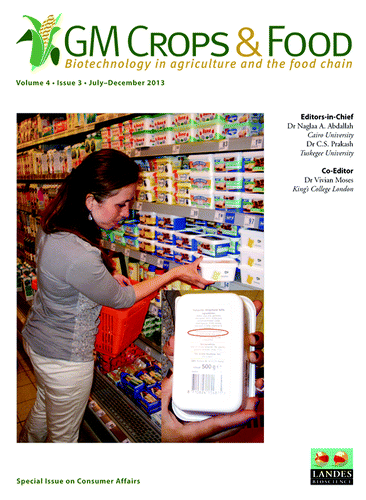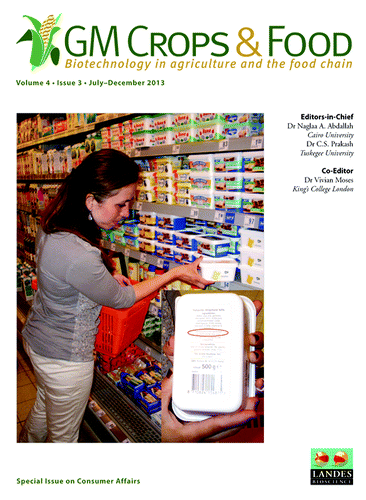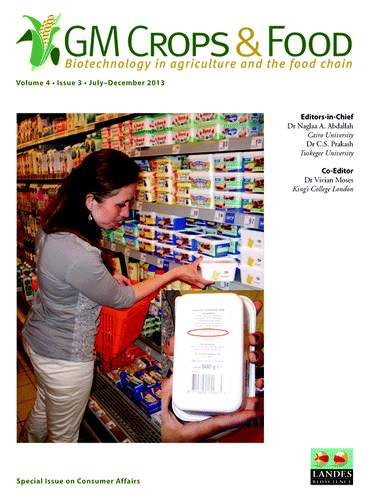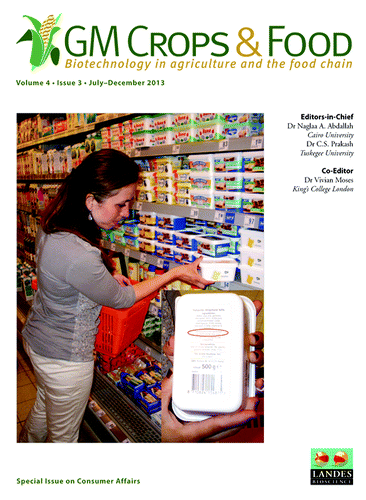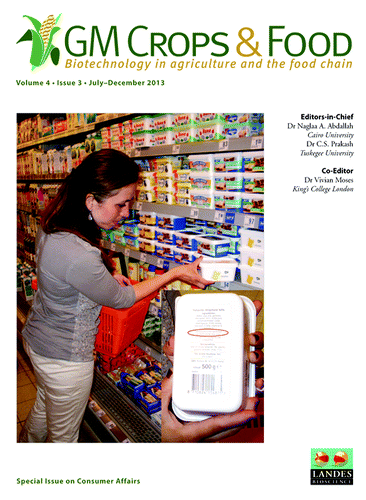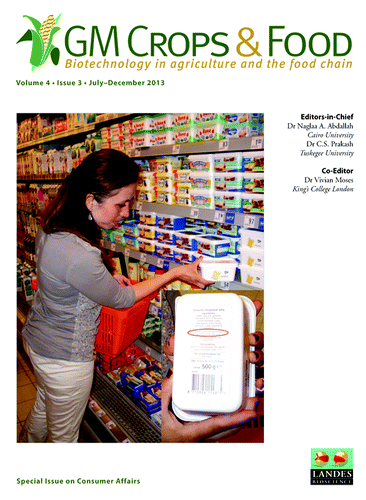Three recent US patent decisions in favor of the biotech industry
In this article, Drew L Kershen from the College of Law, University of Oklahoma, reviews three recent patent decisions involving biotechnology.
In the Myriad Genetics case, the Supreme Court ruled that the patents of Myriad on the cDNA sequence of the BRCA1 and 2 genes are valid.
In the Bowman case, a farmer had bought herbicide resistant soybean seed intended solely for food or feed and re-planted them for several seasons. Monsanto sued the farmer for patent infringement and won the case.
In the OSGATA case, a coalition of farmers, seed sellers, and agricultural organizations challenged Monsanto’s patents as unenforceable and invalid. As they failed to prove that their pleadings showed a justifiable case or controversy, and US courts do not decide hypothetical issues, the case was rejected ().Citation1
The GM labeling debate in the US
In this article GE Merchant and GA Cardineau summarize about 20 y of ongoing debate on labeling of GM foods in the US. In 1992, the Food and Drug Administration (FDA) published a “Statement of Policy” in the Federal Register stating that it will apply the identical approach to GM and non GM food. This means that, as a class, GM-foods do not require labeling. The agency has not changed its position until today. The main focus of pro-labeling activists has therefore turned to state level, with individual states considering mandatory labeling, even though the United States have a de facto non-GM label in place, as GM foods cannot be labeled as “organic” ().Citation2
What does “GM-free” mean?
The growing presence of GM-crops and their products is paralleled by efforts to keep some part of the agriculture and food free from GM crops. In agricultural commodity trade, the principles of thresholds or tolerances are usually applied; different levels of GM content are tolerated in different regions: in the EU and Russia, it is 0.9%, and in Australia and New Zealand, it is 1%, while in Japan it is 5%. This article provides an excellent analysis of the commercial and legal consequences that result from the current policy ().Citation3
Co-existence of GM and conventional crops
In this article, the practicability of co-existence between GM and and conventional farming is discussed. After an introductory paragraph explaining the principles of co-existence, practical examples are cited and the EU political and regulatory context is explained. GM crop cultivation in Spain is cited as one example where co-existence is working well ().Citation4
Can GM Be Bad for the Image?
One frequent argument in New Zealand against the adoption of GM technology is the fear that the “green and clean” country image might be damaged, resulting in harm to export markets and the tourism industry. Interviews with gatekeepers in the food distribution channel and first time visitors to New Zealand showed that long-term deleterious effects on perceptions overseas are highly unlikely ().Citation5
What do surveys on consumer choice really tell us?
In 5 different articles, consumer surveys and experiments on different aspects of GM crops and foods are presented and discussed. Consumers purchasing behavior can be quite different to their attitude and behavioral intention for buying GM food, with many different factors influencing the actual purchasing behavior ().Citation6-Citation10
Why is Europe so different?
This paper examines the differences in acceptance of GM in agriculture in America and in Europe. In the US, the biotechnology industry has been able to overcome the objections of the environmentalist, and consumers and regulators have been convinced that adoption of GM technology is worthwhile.
Five different stakeholders (GM technology input suppliers, farmers, consumers, environmental activists/media, and policymakers) and their main motivations are described. One conclusion from the analysis performed in the paper is that acceptance of GM is more likely if the engineered traits provide consumer benefits, like improvement in nutrition, or direct environmental benefits ().Citation11
References
- Kershen DL. Three recent US patent decisions. GM Crops Food 2013; 4:122 - 5; http://dx.doi.org/10.4161/gmcr.26251; PMID: 23970059
References
- Marchant GE, Cardineau GA. The labeling debate in the United States. GM Crops Food 2013; 4:126 - 34; http://dx.doi.org/10.4161/gmcr.26163; PMID: 23982076
References
- Moses V, Brookes G. The world of “GM-free”. GM Crops Food 2013; 4:135 - 42; http://dx.doi.org/10.4161/gmcr.25992; PMID: 24401659
References
- Pearsall D. GM crop co-existence: a question of choice, not prejudice. GM Crops Food 2013; 4:143 - 50; http://dx.doi.org/10.4161/gmcr.26303; PMID: 23988874
References
- Knight JG, Clark A, Mather DW. Potential damage of GM crops to the country image of the producing country. GM Crops Food 2013; 4:151 - 7; http://dx.doi.org/10.4161/gmcr.26321; PMID: 24002524
References
- Colson G, Rousu MC. What do consumer surveys and experiments reveal and conceal about consumer preferences for genetically modified foods?. GM Crops Food 2013; 4:158 - 65; http://dx.doi.org/10.4161/gmcr.26322; PMID: 24002523
- Sleenhoff S, Osseweijer P. Consumer choice: Linking consumer intentions to actual purchase of GM labeled food products. GM Crops Food 2013; 4:166 - 71; http://dx.doi.org/10.4161/gmcr.26519; PMID: 24051512
- McHughen A. GM crops and foods: what do consumers want to know?. GM Crops Food 2013; 4:172 - 82; http://dx.doi.org/10.4161/gmcr.26532; PMID: 24051491
- Desaint N, Varbanova M. The use and value of polling to determine public opinion on GMOs in Europe: limitations and ways forward. GM Crops Food 2013; 4:183 - 94; http://dx.doi.org/10.4161/gmcr.26776; PMID: 24225741
- Powell DA. Surveys suck: Consumer preferences between Europe and North America in acceptance of GM crops. GM Crops Food 2013; 4:10 - 5; PMID: 23160540
References
- Zilberman D, Kaplan S, Kim E, Hochman G, Graff G. Continents divided: Understanding differences between Europe and North America in acceptance of GM crops. GM Crops Food 2013; 4:202 - 8; http://dx.doi.org/10.4161/gmcr.26981; PMID: 24281195

